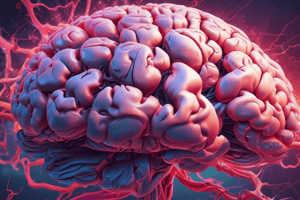Podcast
Questions and Answers
Where is the cerebrospinal fluid primarily formed?
Where is the cerebrospinal fluid primarily formed?
- In the arachnoid villi
- In the ependymal cells
- In the pia mater tissue
- In the choroid plexus (correct)
What is the main function of the arachnoid villi?
What is the main function of the arachnoid villi?
- To reabsorb cerebrospinal fluid into the venous blood (correct)
- To produce cerebrospinal fluid
- To regulate cerebrospinal fluid pressure
- To facilitate the flow of cerebrospinal fluid
What happens to the cerebrospinal fluid pressure when a small amount of fluid is removed during a spinal tap?
What happens to the cerebrospinal fluid pressure when a small amount of fluid is removed during a spinal tap?
- It decreases (correct)
- It remains the same
- It becomes irregular
- It increases
How often is the cerebrospinal fluid replaced in a day?
How often is the cerebrospinal fluid replaced in a day?
What is the approximate volume of cerebrospinal fluid in the central nervous system?
What is the approximate volume of cerebrospinal fluid in the central nervous system?
What is the primary function of cerebrospinal fluid in the brain?
What is the primary function of cerebrospinal fluid in the brain?
What is the result of excess cerebrospinal fluid accumulation in the brain?
What is the result of excess cerebrospinal fluid accumulation in the brain?
What is the significance of the tight junctions in the blood-brain barrier?
What is the significance of the tight junctions in the blood-brain barrier?
What is the composition of cerebrospinal fluid compared to plasma?
What is the composition of cerebrospinal fluid compared to plasma?
What is the purpose of surgically shunting excess cerebrospinal fluid to veins elsewhere in the body?
What is the purpose of surgically shunting excess cerebrospinal fluid to veins elsewhere in the body?
Flashcards are hidden until you start studying
Study Notes
Cerebrospinal Fluid
- Cerebrospinal fluid (CSF) is a special fluid that surrounds the central nervous system (CNS).
- CSF is primarily formed by the choroid plexus, found in the ventricles of the brain.
- Choroid plexus consists of richly vascularized masses of pia mater tissue that projects into pockets formed by ependymal cells.
- CSF flows through the 4 interconnected ventricles in the brain and the spinal cord's central canal.
- CSF escapes through small openings from the 4th ventricle into the subarachnoid space, surrounding the brain and spinal cord.
- CSF is reabsorbed into the venous blood through the arachnoid villi, maintaining a pressure of about 10mmHg.
Functions of Cerebrospinal Fluid
- CSF serves as a shock-absorbing fluid, cushioning the brain from bumps against the skull.
- CSF has a similar density to the brain, allowing it to suspend the brain in its fluid environment.
- CSF facilitates exchange of materials between the body fluid and the brain.
- CSF composition influences the brain interstitial fluid, with a lower K+ concentration and higher Na+ concentration.
Blood-Brain Barrier
- The blood-brain barrier is a highly selective barrier that regulates exchange between the blood and the brain.
- The barrier consists of anatomical and physiological factors.
- Capillary walls in the brain have tight junctions, sealing the wall and preventing free exchange of plasma components.
- The blood-brain barrier shields the brain from harmful changes in the blood, while allowing essential ions to move down the concentration gradient for nerve impulse conduction.
Studying That Suits You
Use AI to generate personalized quizzes and flashcards to suit your learning preferences.




